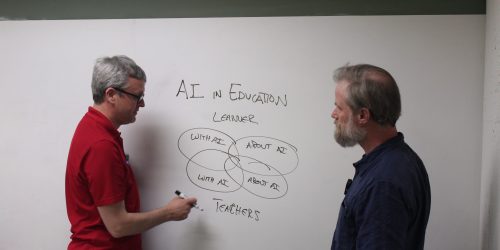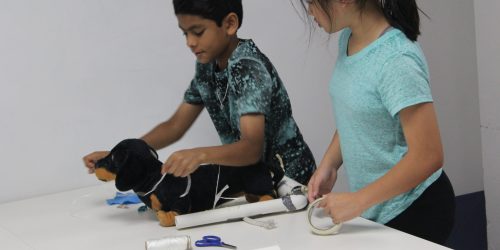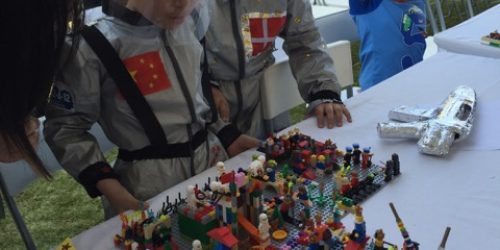This summer of 2021, Tufts Center for Engineering Education and Outreach (CEEO) employed 35 Tufts undergraduate interns to work in CEEO and remotely over the months of June, July, and August. Summer interns did a variety of different research and outreach work this summer. Below are a few highlights of projects that summer interns worked on that we hope you will enjoy reading about.
Springboard Grant
During the Spring 2021 semester, a new portfolios course for sophomore mechanical engineers was offered. Co-taught by Briana Bouchard and Professor Kristen Wendell, it gave strategies for content creation, layout, and opportunities for feedback from peers, faculty, and alumni. Data from small group discussions, weekly homework and journal responses, and whole class discussions were collected to understand the use of portfolios in engineering education. The purpose of the research was to understand the role of portfolios as alternative tools for assessment.
Over the summer, two research assistants helped categorize and analyze the data. The first few weeks consisted of organizing data in a content log, and each video or written response was looked over. Interesting quotes and general content were picked out and attached making themes easier to identify. Conversations of interest were flagged for whole group discussion. These included implicit or explicit mentions of how the students learn Diversity, Equity,and Inclusion (DEI), thoughts on what engineering is, and ideas of traditional assessment. In research meetings, short video clips and individual student work were discussed to find overarching themes between students. Individual student decisions on excluded content between portfolio drafts were also of interest. Specific videos were chosen for transcription and a method of open coding was used for analysis. Coding was done during the last few weeks, as well as Zoom interviews with students that were in the class. Interviews with faculty are nearly finished, and Briana will be analyzing both sets of interviews.
It’s too early to share conclusions without possibly biasing future interviewees, but interviewed students said the class eased fears of being behind their peers and having a dedicated class for portfolio creation would be useful to all mechanical engineers.
Intelligent Robotic Pets
Rebecca Shen & Natalie Sheehan
People have been imagining lifelike robotic pets for as long as there has been science fiction. Toy robots have entertained children for multiple generations now, but they have mostly been mindless automatons. With recent advancements in coding and machine learning technology, today there are multiple models of popular robotic pets available for purchase that are significantly “smarter” than simple toys. What better way to excite and engage students than to give them the opportunity to build their own interactive pets that they can then train to do tricks?
Rebecca and Natalie have been designing and building robotic dogs using the LEGO SPIKE Prime kits plus some fun add-ons like WIFI dongles that allow the pups to upload and download data and work directly with APIs (Application Programming Interface) online. This means the pet itself has access to far more computing power than the SPIKE hub would have on its own. By designing code that gives the robots online access to artificial intelligence and IOT (Internet of Things) tools like Google’s Teachable Machine and PTC’s Thingworx, Natalie and Rebecca’s pets can perform tricks like recognizing and responding to different hand gestures and spoken words, and even “feel” itself being petted.
The thing that makes these pooches truly “intelligent” is that they learn these tricks not by being programmed to do so, but by actually being trained by a user much like how a human trains a real pet. The robotic dogs are able to take sensory input (like listening for different sounds or feeling the pressure of the petting on the force sensor) and do its own work to sort and categorize the data, recognize patterns, and respond accordingly. If students are interested in learning how it all works or even training their pets to perform more complex tasks, they can access the code themselves and see how the machine learning algorithms sort and process the data. Students wanting to go even deeper can play with the code and see how modifications affect changes in their pet’s behavior.
Currently, they’re exploring opportunities for incorporating AR (Augmented Reality) as a means of visualizing how their pets are interacting with their surroundings. As Natalie and Rebecca continue to develop their robotic dogs with more ways of sensing the world, the possibilities for methods of pet training keep expanding. With the growing importance of teaching students about human/AI interactions, these robotic pet projects are as relevant as they are engaging.
Wio Smart Robotics and Storytelling
Anmol Baruwal
Smart Motors are an ongoing project at the CEEO that is producing all kinds of fun developments and new insights into how students and teachers can work directly with machine learning systems to explore and learn about artificial intelligence without the need for computers or writing code. Anmol is spending the summer further developing a particular incarnation of the smart motor, utilizing the Seeed Studio Wio Terminal, a microcontroller with a viewscreen used for fast prototyping. This terminal is quite handy because along with the viewscreen and buttons, it also has multiple sensors already built in for light, infrared, and movement.
Along with exploring the addition of new sensors and inputs such as a microphone and a potentiometer, Anmol is also experimenting with the educational applications of utilizing smart motor technology with an interdisciplinary approach to literature. Inspired by Novel Engineering, Anmol has been testing his Wio smart motor capabilities by having groups of students use them to design solutions to events and situations found in books. Called “Wio with Story”, he and the participants train their smart motors to perform an action and incorporate it into a device that reacts to its environment on command without doing any coding or interfacing with a computer.
Anmol is applying this tech in his home country of Nepal, where later this week he will be conducting an online hackathon with collaborators at Karkhana to test more design ideas. In the hands of creative users, there seem to be nearly infinite possibilities for hands-on applications.



